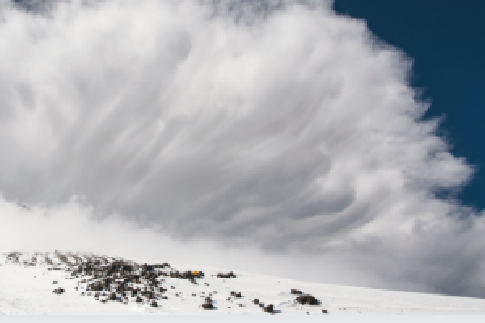The Wilderness Medical Society convened an expert panel to develop evidence-based recommendations for three primary aspects of avalanche accidents: prevention, rescue, and resuscitation. Nonavalanche deep snow and tree well burial were included as related conditions with pathophysiology and recommendations similar to avalanche burial.
PREVENTION
Prevention of avalanche morbidity and mortality includes four components: avoiding being caught in an avalanche, avoiding burial if caught, minimizing trauma if caught, and avoiding asphyxia if buried. Travelers in avalanche terrain should obtain avalanche education by attending training courses, using educational books and videos, and regularly practicing safe travel and rescue skills. They should use avalanche advisories, and a decision aid to help with trip planning and route finding in avalanche terrain. Backcountry travelers should exercise conservative judgment and risk-mitigation strategies to avoid triggering and being caught in an avalanche.
If caught in an avalanche, one should immediately attempt to escape the moving snow or, if engulfed, fight in any way possible to avoid complete burial. If one cannot escape the moving snow, a victim should jettison skis and snowboards. Using a backpack while traveling in snow may help mitigate trauma if caught in an avalanche.
Travelers entering avalanche terrain should consider using an avalanche airbag for burial protection; however, no data are available to suggest airbags prevent trauma. Familiarity and regular practice with airbags are essential, since failure rates are in part due to user error. Helmets should be considered for trauma protection. If caught in an avalanche, a victim should protect their airway and create an air pocket by reaching across the face with one arm, placing the crook of the elbow over the mouth. Travelers entering avalanche terrain should consider using an artificial air pocket device to protect the airway.
Backpack shown with an airbag deployed and inflated, combined with an artificial air pocket device.
RESCUE
During an avalanche accident, the rescuers should follow an algorithm (Figure 2): establish leadership, secure the scene, perform surface, transceiver and pinpoint (probe) searches, shovel strategically, and notify emergency services when appropriate, which may need to be delayed due to the urgency of searching for and digging out a buried victim. All travelers in avalanche terrain should carry avalanche transceivers, know how to perform effective searches, and practice regularly. Rescuers should keep transceivers a minimum of 20 cm from other electronics and metal objects in transmit mode and a minimum of 50 cm in search mode. All travelers in avalanche terrain should carry and know how to use a 3-meter collapsible probe for the pinpoint search. The technique should include probing in a perpendicular fashion using a concentric circular pattern with probe holes spaced 25 cm apart. All travelers in avalanche terrain should carry and know how to use a metal shovel designed for avalanche debris. Shoveling techniques should include using the shovel like a paddle to plow snow downhill. A conveyor belt technique should be used if multiple rescuers are available.
Avalanche rescue sequence.
RESUSCITATION
A completely buried patient, even if uninjured, should be transported to the nearest medical facility capable of evaluating and stabilizing the patient. Avalanche resuscitation should include trauma care and hypothermia care.
If vital signs are not detectable, and there are no indications for withholding resuscitation, rescuers should start CPR and ALS while further assessment is performed. If return of spontaneous circulation is not achieved after at least 30 minutes, resuscitation attempts may be stopped (with certain exceptions below).
If duration of burial is ≤ 60 minutes, standard resuscitation and ALS, if possible, should be performed. If duration of burial is > 60 minutes, the core temperature < 30°C/86°F and the victim had a patent airway, arrest may be due to hypothermia; CPR should be continued, and the patient transported to a hospital with ECLS capability.
If available, mechanical chest compression should be used for difficult and long transports. If continuous CPR is not possible, intermittent CPR can be performed with ≥ 5 minutes of CPR alternating with ≤ 5 minute interruptions.
Several indications suggest one can withhold or terminate resuscitation:
- If a completely buried victim is in cardiac arrest that has clearly been caused by trauma.
- If a victim is completely frozen.
- If a victim is found pulseless and apneic with an obstructed airway and duration of burial is > 60 minutes and core temperature > 30°C/86°F.
- If an avalanche victim who has a serum potassium of > 8 mmol L-1.
- If rescuers are at high risk from terrain or weather, further rescue attempts should be delayed until conditions improve or risks can be mitigated.
- If resuscitation attempts exceed 30 minutes.
NONAVALANCHE SNOW BURIAL
Avoiding falling into tree wells and deep powder snow are the only known means of preventing nonavalanche snow burial (NASB), that is, in tree wells or open slopes in deep powder snow. Maintaining vocal and visual contact with a partner, yelling to alert a partner to a fall, and grabbing tree branches to stay upright during a fall may prevent NASB, although the effectiveness of these measures have not been confirmed. A victim should keep skis or snowboard attached to avoid sinking deeper and to provide visual clues to rescuers. There is insufficient evidence to recommend use of transceivers, avalanche airbags or artificial air pocket devices to prevent NASB.
REFERENCE
Van Tilburg C, Grissom CK, Zafren K, McIntosh S, Radwin MI, Paal P. Wilderness Medical Society practice guidelines for prevention and management of avalanche and nonavalanche snow burial accidents. Wilderness Environ Med. 2017;28(1):23-42.
Published February 19, 2020
Volume 37, Issue 1
Learn more about the Wilderness Medical Society and how you can join as a member and help us lead the worldwide community of Wilderness Medicine.


